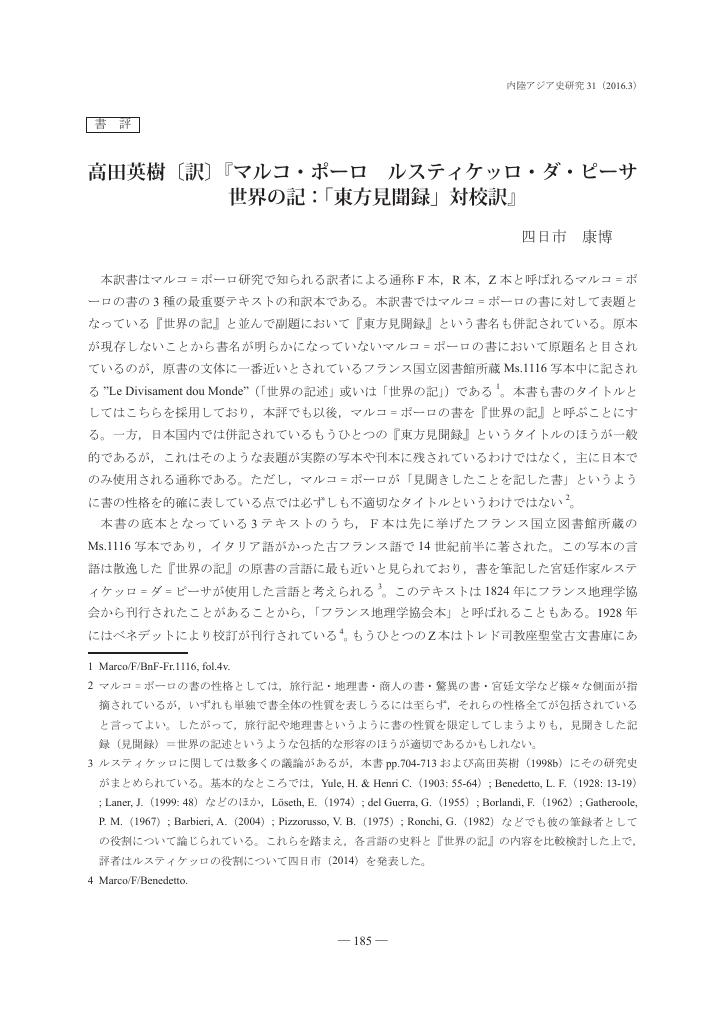- 著者
- 四日市 康博
- 出版者
- 内陸アジア史学会
- 雑誌
- 内陸アジア史研究 (ISSN:09118993)
- 巻号頁・発行日
- vol.31, pp.185-196, 2016-03-31 (Released:2017-05-26)
- 著者
- 四日市 康博 ヨッカイチ ヤスヒロ Yasuhiro Yokkaichi
- 雑誌
- 史苑
- 巻号頁・発行日
- vol.75, no.2, pp.257-300, 2015-03
3 0 0 0 「14世紀の危機」についての文理協働研究
本研究は、「14世紀の危機」に焦点を当てるものである。「14世紀の危機」とは、「中世温暖期」から「小氷期」への移行期にあたる14世紀に起きたユーラシア規模での、1)気候変動、2)社会動乱、3)疫病流行、これら3つの複合要素から成り、ユーラシア史を不可逆的に転換させた「危機」を意味する。本研究では、気候の変動は人間社会にとって特に対応の難しい20年から70年ほどの周期で「危機」を最大化するという仮説に基づいて議論を進める。100年単位の生態系の長期遷移と、社会や気候の短期のリズムとのあいだにある中間時間を、気候データと文献データとの組み合わせによって危機のサイクルとして析出する。
2 0 0 0 IR 史苑の窓 声と色から読み解く歴史文書学 : イランのモンゴル帝国期命令文書から
- 著者
- 四日市 康博 ヨッカイチ ヤスヒロ Yasuhiro Yokkaichi
- 出版者
- 立教大学史学会
- 雑誌
- 史苑 (ISSN:03869318)
- 巻号頁・発行日
- vol.80, no.2, pp.1-13, 2020-03
1 0 0 0 OA 声と色から読み解く歴史文書学 : イランのモンゴル帝国期命令文書から
- 著者
- 四日市 康博 ヨッカイチ ヤスヒロ Yasuhiro Yokkaichi
- 雑誌
- 史苑
- 巻号頁・発行日
- vol.80, no.2, pp.1-13, 2020-03
- 著者
- 四日市 康博
- 出版者
- 公益財団法人 史学会
- 雑誌
- 史学雑誌 (ISSN:00182478)
- 巻号頁・発行日
- vol.113, no.12, pp.2078, 2004-12-20 (Released:2017-12-01)
1 0 0 0 OA ジャルグチ考 : モンゴル帝国の重層的国家構造および分配システムとの関わりから
- 著者
- 四日市 康博
- 出版者
- 公益財団法人 史学会
- 雑誌
- 史学雑誌 (ISSN:00182478)
- 巻号頁・発行日
- vol.114, no.4, pp.443-472, 2005-04-20 (Released:2017-12-01)
Jarruci is generally regarded as a judge; however, the post included not only judicial duties but also management of census registers and fiscal administration. Although the relation of census registers to jarruci has not attract researchers' attention to date, it is a matter of no small importance in the structural fabric of the Mongol Empire. In the Secret History of the Mongols, there is a description of the origin of jarruci. It seems that Cinggis Qan decreed to share out people to his clan and establish jarruci at a time. It shows that the jarruci's two duties were interrelation, that is to apportion qubi (assigned territories, people and possessions) shared out among the imperial princes and to try transgressors by jarru. The nomadic groups multilayeredly formed by sharing among the Cinggised lines and dominant noyans were called ulus. One ulus corresponded to each jarruci's jurisdictional limits. Jarruci's administrative role was closely connected to the structure of the Mongol Empire composed of multilayered uluses. From superordinate ulus to subordinate ulus, sharing olja (spoils) were shared as qubi. At the connecting points of such a multilayered social structure, jarruci apportioned qubi justly, and kept order among the ulus. Jarruci investigated olja and reported the results to the qan of his ulus, then carried out the apportionment of qubi as ordered by the qan. At the same time, jarruci were dispatched from subordinate ulus to superordinate ulus to ensure qubi of his ulus. Jarruci, in other words, redistributed qubi inside their own ulus and as a dispatched offical ensured qubi outside their own ulus. Ulus and ulus, sedentary territories and nomadic territories were connected by jarruci, and thereby the Mongol Empire was able to maintain a certain degree of uniformity as a single state.
1 0 0 0 元代の海域世界史 (世界史の研究(248))
- 著者
- 四日市 康博
- 出版者
- 山川出版社
- 雑誌
- 歴史と地理 (ISSN:13435957)
- 巻号頁・発行日
- no.696, pp.50-53, 2016-08
1 0 0 0 IR 元朝南海交易経営考--文書行政と銭貨の流れから
- 著者
- 四日市 康博
- 出版者
- 九州大学文学部東洋史研究会
- 雑誌
- 九州大学東洋史論集 (ISSN:02865939)
- 巻号頁・発行日
- no.34, pp.133-156, 2006-04
- 著者
- 四日市 康博
- 出版者
- 早稲田大学文学部東洋史学専修室
- 雑誌
- 史滴 (ISSN:02854643)
- 巻号頁・発行日
- no.37, pp.128-107, 2015-12
- 著者
- 四日市 康博 ヨッカイチ ヤスヒロ Yasuhiro Yokkaichi
- 出版者
- 立教大学史学会
- 雑誌
- 史苑 (ISSN:03869318)
- 巻号頁・発行日
- vol.75, no.2, pp.257-300, 2015-03

